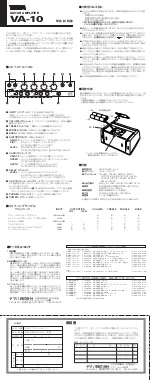
9
4.
CONTROLS
4.01 Output Mode Link:
The "OUTPUT" jumper link is set to "V" for voltage output or "mA" for current output.
Three 20-turn screwdriver-adjusted controls are provided for controlling:
4.02 Excitation
- allowing continuous variation of excitation between 3V and 10V.
Note
: if supply is
<13V, the max. excitation voltage available is Vs - 3V.
Note
: for units of MOD18
onward, if operating temperature exceeds 70°C then the maximum current is 60mA,
4.03 Zero
- allowing a fine adjustment of output zero of approximately ±2V (or 0-10mA)
depending on Fine Gain setting.
4.04 Fine Gain
- allowing a 4:1 variation in amplifier gain, used in conjunction with 4.05.
4.05 Gain Range (x1 to X1250)
-
sliders 1 to 4 of the 6-slider DIL switch, when used with the fine gain control,
provide an output of 5V or 4-20mA with an input signal range of approx. 4mV to
5V as shown below:
(also output ± 5V for input ±4 mV to ±5V)
SLIDERS
ON
For Mod.8 (and above)
For ±10V
OUTPUT
INPUT SIGNAL RANGE for: 5V or 4-20mA OUTPUT
4 + 3 + 2
4
– 16mV
±8 to ±32mV
4 + 3
5
– 20mV
±10 to ±40mV
4 + 2
18
– 70mV
±35 to ±140mV
4 + 1
65
– 270mV
±130 to ±500mV
4
0.25
– 1V
±0.5 to ±2V
1
0.34
– 1.35V
±0.7 to ±2.7V
None
1.25
– 5V
±2.5 to ±10V
Note: for the two lowest gain ranges (with slider 4 off), the excitation voltage must be
5V
to provide signals within the required common mode voltage range of the amplifier.
Note: for ±10V output, the supply must be at least 22V or ±11V (see 4.10).
4.06 Shunt Calibration
- slider 5 ("C") of the 6-slider DIL switch, when set to ON connects an internal 59k
Ω
0.1% resistor across one arm of the bridge.
Remote Cal.
- an internal relay may be used to remotely connect the 59k
Ω
resistor. To
operate this relay, connect the R-Cal. terminal to V- (CON 2) at any convenient point (lead
length is irrelevant) via a switch, etc.
Note 1: For normal relay operation, the supply voltage must be at least 15V. For lower
supply voltages, solder link SP2 must be made (see Fig.1).
Note 2: For normal shunt calibration, connect the CAL terminal to Sig- (CON 1). This links
the internal calibration resistor (terminal 6) to the relevant bridge node.


































